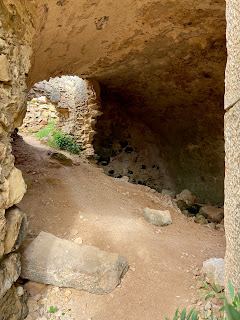The way home is through Castro Verde (pop 7,276 in 2011) – at Christmas we drove through Beja. Castro Verde is a much smaller village, with fewer sites and lunch options, but we want to give the 'underdog' a try. Here is José Saramago's introduction:
Castro Verde is as green as its name suggests. Perched on a hill, it has more than enough vegetation to soothe the eyes from the harshness of the plain. If the traveller were only concerned with monuments today, it would hardly be worth his while having come so far to see what is here, despite the value of the experience of crossing forty kilometres of scorched earth. The church of the Chagas do Salvador is open, and can show some charming paintings of battle scenes, as well as a panel of tiles, but the parish church, here given the title royal, is firmly shut. (José Saramago, “Journey to Portugal,” 1990; trans Hopkinson-Caistor, 2000)
We park near the Basílica Real (sixteenth century, Nossa Senhora da Conceição), but as Saramago found, the church is locked. Despite its severe exterior, the interior is covered with azulejos. We recall our failure at Almancil; another tiled beauty avoids our cameras (another return trip to plan).
A pleasant promenade through the Praça do Municipal brings us to the Igreja das Chagas do Salvador (sixteenth century, Nossa Senhora dos Remédios), which is open. The pediment features several wonderful finials and swirls, worn like a hairstyle on an otherwise plain facade. We ask the docent inside who explains that the Basílica Real is closed, and goes back to his book – though friendly, we do our best not to disturb him.
Both the Igreja and the Basílica are originally built to commemorate Dom Afonso Henriques' victory at the Batalha de Ourique (July 25, 1139) during the Reconquista (the battlefield marker is nearby). So, the paintings here and the tile panels there tell similar stories, in which the Salvador appears before the king and inspires the outnumbered Portugueses to victory over the Almorávidas. Thus, the victory is a 'milagre' (miracle), and Afonso proclaims himself Rei dos Portugueses.
An image of the martyred Christ appearing before Afonso hangs near the entry vestibule, and is also on the brasão in the Jardim de Castro Verde (top image – feels cruel that the Messiah would appear still nailed to the cross).
The victory also marks the origin of the Bandiera das Quinas, signifying the Cinco Santa Chagas (Five Holy Wounds) of Christ, the five defeated Moorish kings. The canvases of the Batalha (eighteenth century), as well as those representing the Evangelists at the top of the archway, and scenes of the life of the Virgin on either side of the altar mor, are by Diogo Magina, a painter from the Algarve. Though they could all use a cleaning, the images are bold, clear, and expressive; this includes the beheading to the Moorish kings and the crowning of 'Afonso I'.
(Note that Dom Afonso Henriques is the great-great-great-great-great-great-grandfather of Infante Dom Henrique – hope that's right; and July 25th is also the Feira de Sant'Iago, "o Matamoros".)
There are four azulejos story panels near the altar and six additional painting which illustrate the Marian cycle, including Her Marriage to St Joseph, the Annunciation, and the Adoration of the Magi. The Cinco Santas Chagas also appears in the ceiling crest.
But the figures of the chapel saints appear to come from the same 'shop'. Though unlabeled, the female saint with the crown of roses, anchor, and arrows must be Santa Filomena (canonized for healing sick children, remédios). And the tiles in the main worship space are the same type of commercial Dutch tiles that might be in local homes. They create a regular, gridded texture below the canvases, yet add the local flora, fauna, and character. Perhaps humble in origin, these 'store-bought' pieces complete the story and the look of this "charming" interior.
Just around the corner from the Igreja, we find the eaves of village's correios (post office) dotted with swallows' nests, and a swarm of dark little birds whizzing around the traffic circle. On the Rua Morais Sarmento, the town has recently created a pedestrian shopping street (as the sign attests), an old moinho de vento (windmill) and the fields of the Baixo Alentejo in the distance. Just as we are taking pictures, a young man rolls by in a donkey cart.
Then, just down the street from the Praça da Liberdade, while searching for a lunch spot, we stumble onto the Casa Dona Maria, an early twentieth century manor house built by local farmer Álvaro Romano Colaço. It features a multi-leveled formed-concrete balustrade and a series of ornamental watch towers.
Having come from the world's edge, a stop in this eccentric and historic village is "worth our while".

















































































